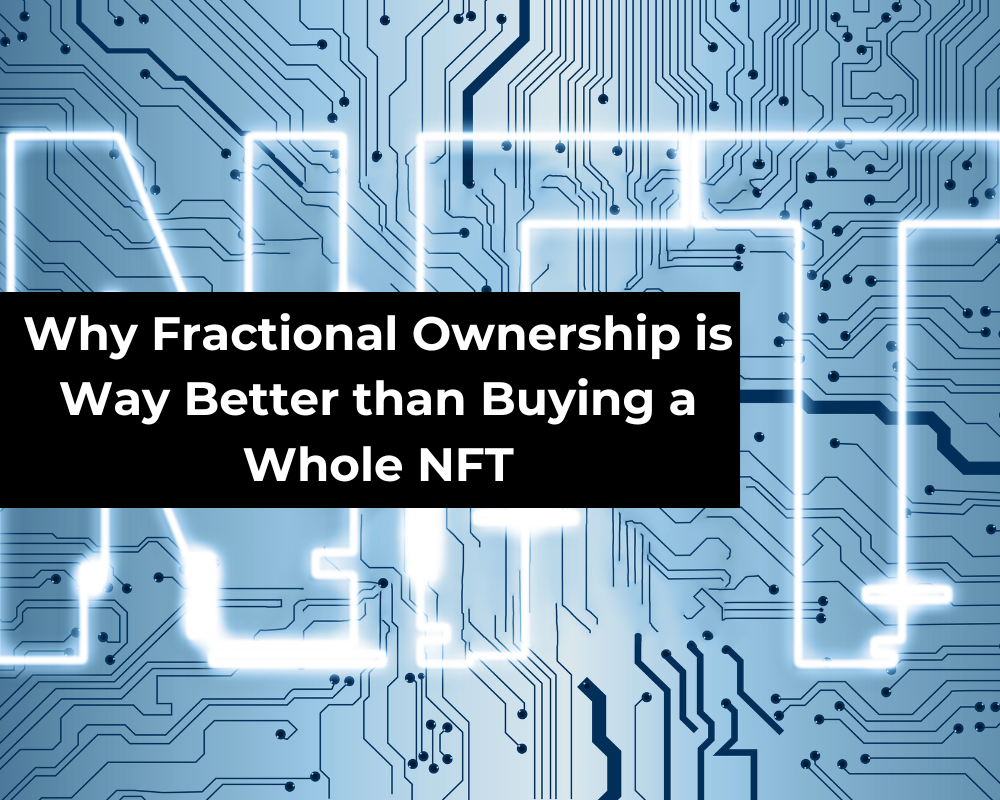
Why Fractional Ownership is Way Better than Buying a Whole NFT
Since their debut, Non-Fungible Tokens (NFTs) have become a hot topic, grabbing everyone’s attention. But while some are fully on board with the trend, others are still unsure about what are the NFTs and their value. And why is that? Simply because of their extreme costs, they are inaccessible to small-budget investors. Some NFTs sell for huge amounts, making them out of reach for many. This includes some of the most popular and pricey NFTs like ‘The Merge,’ ‘CryptoPunk,’ and many more.
Interestingly, Ape CryptoPunk #5577 from the renowned CryptoPunk NFT collection was sold for a whopping amount of 2501 ETH (equal to $7.7m at the time of purchase). While this is only one example of the most expensive NFTs to date, most NFTs today sell at a hefty rate, making them inaccessible to small-budget investors. Here, fractional NFTs emerge as an efficient solution.
Although initially met with skepticism, NFT fractionalization has quickly gained popularity over the years. And what exactly is a fractional NFT? As the name suggests, these tokens allow shared ownership, meaning you don’t have to buy a whole expensive NFT to get a piece of the asset. Hence, instead of paying staggering prices, you can split NFTs into fractions and own them apart.
This article will explore why fractional ownership beats buying a whole NFT. We will also discuss the use cases of F-NFTs and how you can conveniently purchase fractional NFTs. So, without any delay, let’s explore!
What are F-NFTs?
So, what are the NFTs that are available for fractional ownership? If you’re unsure about what exactly is a fractional NFT, let’s break it down. Similar to buying shares in a company, investors can now purchase fractions of high-value NFTs, expanding opportunities in the digital asset market.
Traditionally, NFTs, or non-fungible tokens, have been indivisible ERC-721 tokens. However, with the advent of fractionalization, these tokens can now be divided into smaller units represented by ERC-20 tokens. This process involves locking the original NFT into a smart contract, which divides it into fractions, each denoted by its ERC-20 token.
Imagine it as breaking down a valuable piece of art into smaller pieces, each still holding a portion of the original NFT’s value. This fractionalization allows investors to purchase fractions of the NFT, and pricing is set until the complete NFT is sold. It’s like a digital form of collective ownership where individuals can come together to invest in assets that would otherwise be out of reach.
Interestingly, Fractional NFTs are making the crypto investment industry more accessible and inclusive for everyone, offering a democratized approach to owning valuable digital assets. Amidst this rising trend, platforms like Ommniverse are emerging as reliable hubs for Fractional NFTs, allowing investors to explore exciting fractional ownership opportunities.
Use Cases of Fractional NFTs
As a rising trend, fractional NFTs are unlocking new possibilities across various industries. This democratizes access to valuable assets and promotes greater engagement and investment opportunities for individuals on a global scale.
Now, let’s explore some key use cases of fractional NFTs:
- Real Estate Industry: Today, the real estate sector is no stranger to innovation, and fractional NFTs are revolutionizing this sector. Investors can now hold fractional interests in these assets by tokenizing real estate properties. This helps diversify your investment portfolio while serving as a gateway to the real estate market without requiring a large initial investment.
- Ownership of Art and Collectibles: Imagine owning a piece of valuable artwork or collectible item. Fractional NFT ownership makes this possible by allowing enthusiasts to collectively own portions of these assets. This allows investors to hold prestigious art pieces and collectibles, offering shared joy and investment potential to a broader audience.
- Intellectual Property Monetization: Creators often face challenges in monetizing their intellectual property. However, fractionalizing intellectual property, such as music, films, and patents, changes is a great solution in this scenario. This is made possible as F-NFTs allow investors to own fractions of the associated rights and potential revenue streams, providing creators funding while offering backers investment opportunities.
- Sports and Memorabilia: If you’re a sports fan, you would know the level of passion and connection sports fans have for their teams and keepsakes. Here, fractional NFTs bring the fans’ and players’ worlds closer together through marketplaces, allowing fans to own fractions of sports memorabilia, athlete endorsements, or even shares in sports teams. This enhances fan engagement and provides opportunities for fans to benefit from the value appreciation of sports-related assets.
- Luxury Goods and Fashion Ownership: Have you ever dreamed of owning a piece of luxury fashion or a rare, exclusive item? Fractional ownership NFTs make this possible by making shared ownership of luxury goods accessible. This allows individuals to own fractional stakes in high-end fashion accessories or valuable products, creating new opportunities for investment and access to exclusive items.
Step-by-Step Process of Purchasing Fractional NFTs
If you’re ready to explore the world of NFT fractionalization and add diverse assets to your portfolio, it’s important to understand the step-by-step process of purchasing fractional NFTs.
To help you with that, here’s a simple investment guide:
Step 1: Choose Your Platform
Start by selecting a user-friendly platform like Ommniverse that supports NFT fractional ownership with unique features and advantages. Before proceeding further, take your time to understand the platform’s features and options to ensure they align with your specific investment requirements.
Step 2: Set Up Your Digital Wallet
Upon choosing a marketplace, it’s time to finalize the digital wallet that will securely hold your NFT. For this, you can consider popular options, including Metamask, Coinbase Wallet, etc. While at it, ensure your wallet is compatible with your selected platform.
Step 3: Obtain Cryptocurrency
You can engage in fractional NFT investment using the cryptocurrency transactions supported by your selected platform. You can acquire the desired cryptocurrency through your digital wallet to complete the purchase.
Step 4: Navigate the Marketplace
Once your digital wallet and cryptocurrency are ready, it’s time to navigate the chosen marketplace. You can pick from various fractional asset investment options. However, make sure to conduct thorough research before proceeding with any fractional asset investment. This way, you can select a fractional asset that best meets your investment preference.
Step 5 Make the Purchase
When you’ve identified a fractional NFT that interests you, proceed with the acquisition process on the user-friendly platform. You can follow the platform’s straightforward instructions, click ‘buy,’ and then confirm the transaction within your digital wallet.
Once you complete these steps, you will complete your fractional NFT purchase, diversifying your digital asset portfolio with valuable F-NFT holding.
Read: Ftx Crypto Sam Bankman Fried: A Comprehensive Analysis
Why is Buying F-NFTs Better?
Buying fractional NFTs (F-NFTs) offers several advantages over purchasing whole NFTs when investing in NFTs. Some key advantages include:
- Investment Affordability: Fractional ownership allows individuals to own a portion of a valuable NFT, even if they don’t have the financial means to purchase the entire asset. This expands investment possibilities to a wider audience, encouraging inclusivity within the NFT market.
- Increased Liquidity: Fractional NFTs provide enhanced liquidity in contrast to whole NFTs. Because they can be traded in smaller portions, investors enjoy increased flexibility to sell their shares as required. This enhanced liquidity gives investors greater control over their investments and allows for easier portfolio management.
- Portfolio Diversification: Another reason why is buying F-NFTs better is its portfolio diversification benefit. This means that investing in fractional NFTs enables the diversification of investment portfolios. In simpler terms, F-NFTs allow investors to mitigate investment losses by diversifying across multiple NFTs. This diversification strategy helps safeguard against market volatility and fluctuations in the value of individual assets.
- NFT Investment Limitations: Fractional ownership lowers the barriers to entry for NFT investment, making it accessible to a wider range of investors. This inclusivity democratizes the NFT market, allowing individuals from diverse backgrounds to make digital investments.
- Exclusive NFT Ownership: Fractional ownership provides investors access to high-value and rare NFTs that may otherwise be out of reach. So, by owning a fraction of these exclusive assets, investors can participate in the potential appreciation of their value without having to commit to the entire asset.
Conclusion
As NFTs continue to gain traction, fractional ownership is revolutionizing the NFT market by making it more accessible and inclusive.
With its focus on improving user experience through enhanced liquidity, reduced costs, and increased trust, fractional NFT ownership is set to drive further growth and innovation in the NFT industry.
Author’s Bio:
Emy is a seasoned content writer specializing in cryptocurrency and blockchain topics like Fractional NFT and crypto-back. Her work appears in top publications, reflecting her passion for making complex subjects accessible. Outside of writing, she enjoys yoga and spending time with loved ones and pets.
